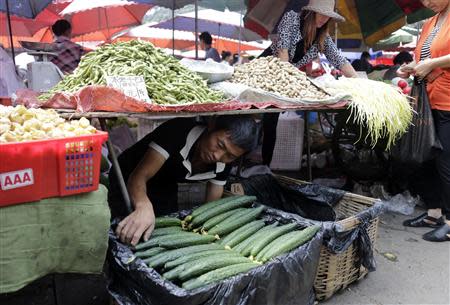China Aug inflation another sign economy is stabilizing
BEIJING (Reuters) - Muted inflation data on Monday added to a run of August figures suggesting the protracted slowdown in China's economy may be bottoming out, helped by targeted support measures and signs of improved export demand. A steady consumer inflation rate also gives the People's Bank of China some room to maneuver in response to any shock that might arise as the U.S. Federal Reserve starts to taper its monetary stimulus. However, any sharp policy shifts in the world's second-largest economy seem unlikely amid concerns about rising property prices and after efforts to curtail unregulated lending. "There is no sign of any shift in monetary policy," said Jerry Hu, an economist at Shanghai Securities, who saw stable consumer prices in the months ahead. "I think monetary conditions will become tighter, probably through a combination of quantitative tightening and low interest rates." Consumer prices rose 2.6 percent in August from a year earlier, the National Bureau of Statistics said, in line with market expectations and July's 2.7 percent rise. Month-on-month, prices were up 0.5 percent, slightly stronger than a forecast rise of 0.4 percent. Producer prices fell an annual 1.6 percent, less than both a market forecast of 1.8 percent and a fall of 2.3 percent in July. While factory-gate deflation has now lasted for 18 months, the pace of decline has steadily eased from a peak of 3.6 percent in September 2012. "The trend of stabilization in the economy is becoming clearer," Yu Qiumei, a senior statistician at the bureau, said in a statement. There are increasing signs that China's economy is finding its feet after slowing in nine of the past 10 quarters, with other data already out for August showing some strength. Exports rose more than expected, helped by improving demand in major markets, and manufacturing surveys suggested capital spending and industrial output have gathered steam in response to government steps to spur investment and promises to push through reforms. As recently as a month ago, investors had worried that China was slipping into a deeper-than-expected downturn, especially after its money market was hit by an unprecedented cash crunch in June as the central bank sought to curtail credit growth. But policymakers have stepped in with a series of measures aimed at stabilizing the economy, including quickening railway investment and public housing construction and introducing policies to help smaller companies with financing needs. Data for industrial output, fixed asset and retail sales come on Tuesday is expected to increase confidence a sharp slowdown has been avoided. Vice Finance Minister Zhu Guangyao has said there was no need for government stimulus and growth could instead be supported through structural adjustments. For its part, the central bank has kept policy stable since the start of this year, with some fine-tuning to support the slowing economy while heading off inflation risks. For now, a major uncertainty is how investors will respond if the U.S. Federal Reserve does begin trimming its stimulus later this month. Some see a risk that a clutch of big developing economies are vulnerable to capital outflows. "Given the weekend trade performance, we think China's economy is stabilizing, but a sustained upside trend is still uncertain," said Li Huiyong, an economist at Shenyin & Wanguo Securities in Shanghai. "The moderation in August imports reflected still weak domestic demand, and we should not underestimate the impact of tapering of U.S. monetary stimulus." Officials have been optimistic about growth, saying there are clear signs of stabilization and that the annual GDP target of 7.5 percent -- a two-decade low -- is achievable. (China Economics Team; Editing by John Mair)


